
Welcome to detroitsnakes.com! I am David, a snake enthusiast living in Detroit, MI. Many people don't know that Detroit is in fact full of snakes! You just need to know where to find them - they can often be shy and elusive. Some Michigan snake species are more common outside of the city limits, in different parts of Wayne County MI, but many types of snakes are indeed common in the more urban parts of Detroit. This guide is meant to help educate you about the beautiful snakes of Detroit, and to help you identify the most common snakes of Detroit, as well as the venomous snakes of Detroit that you should learn to recognize and avoid. If you want more detail, click here for my complete list of ALL snake species in Detroit. Remember the following:
- Most snakes of Detroit are harmless and don't want to encounter you
- Venomous snakes exist but are uncommon in Detroit, Michigan
- Snakes eat rats and mice and are a valuable part of the Michigan ecosystem
- Never kill a snake - if you leave a snake alone, it will leave you alone.
Common Snake Species in Detroit
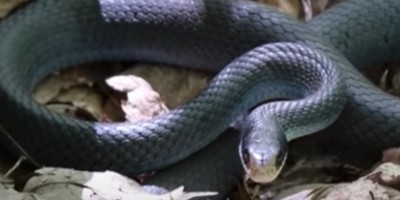 Blue Racer:
Blue racers (Coluber constrictor foxii) are fast, but their brilliant blue scales are hard to miss. Growing around 36 to 60 inches in length, their backs are a darker blue-grey. As their name suggests, they can slither at up to 4 miles an hour. These snakes are active foragers and will hunt for small mammals, insects, songbirds as well as other snakes. However, they are also hunted by birds of prey, raccoons, foxes, dogs, and house cats. They are non-venomous though, so pose no immediate threat.
Blue Racer:
Blue racers (Coluber constrictor foxii) are fast, but their brilliant blue scales are hard to miss. Growing around 36 to 60 inches in length, their backs are a darker blue-grey. As their name suggests, they can slither at up to 4 miles an hour. These snakes are active foragers and will hunt for small mammals, insects, songbirds as well as other snakes. However, they are also hunted by birds of prey, raccoons, foxes, dogs, and house cats. They are non-venomous though, so pose no immediate threat.
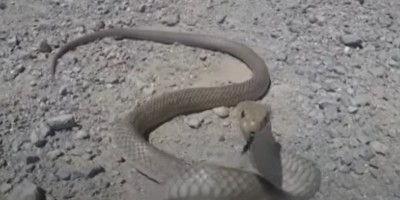 Brown Snake:
The brown snake or Dekay’s brown snake (Storeria dekayi) – to differentiate it from an Australian species – is commonly found in the eastern US. Sometimes confused with red-bellied snakes, it can be distinguished by the absence of the spot behind the head. These snakes are small – measuring around 12 inches – and non-venomous. They mainly feed on slugs, snails, and earthworms. Interestingly, they have a specialized jaw for removing snails from their shells. Cats and dogs will often hunt for Dekay’s brown snakes.
Brown Snake:
The brown snake or Dekay’s brown snake (Storeria dekayi) – to differentiate it from an Australian species – is commonly found in the eastern US. Sometimes confused with red-bellied snakes, it can be distinguished by the absence of the spot behind the head. These snakes are small – measuring around 12 inches – and non-venomous. They mainly feed on slugs, snails, and earthworms. Interestingly, they have a specialized jaw for removing snails from their shells. Cats and dogs will often hunt for Dekay’s brown snakes.
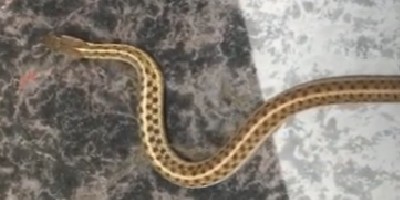 Butler’s Garter Snake:
This slender snake measures 15 to 18 inches in length, with three yellow or orange stripes (garters) running from head to tail. The butler’s garter snake (Thamnophis butleri) is otherwise olive-green to black beneath the stripes. It can be hard to differentiate between other species of garter snake without specific knowledge. These snakes are non-venomous, and you’ll most often find them in grassy vacant lots in suburbia or residential neighborhoods. They hunt for leeches, earthworms, salamanders, and frogs. Otherwise, they are found in marshes, savannas, and grasslands. In many locations, they are endangered, but they are to be found throughout the lower peninsula.
Butler’s Garter Snake:
This slender snake measures 15 to 18 inches in length, with three yellow or orange stripes (garters) running from head to tail. The butler’s garter snake (Thamnophis butleri) is otherwise olive-green to black beneath the stripes. It can be hard to differentiate between other species of garter snake without specific knowledge. These snakes are non-venomous, and you’ll most often find them in grassy vacant lots in suburbia or residential neighborhoods. They hunt for leeches, earthworms, salamanders, and frogs. Otherwise, they are found in marshes, savannas, and grasslands. In many locations, they are endangered, but they are to be found throughout the lower peninsula.
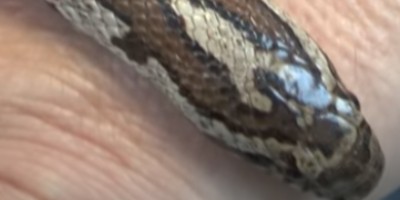 Eastern Milk Snake:
Eastern milk snakes (Lampropeltis triangulum triangulum), also known as the house snake or chicken snake, is a species of kingsnake found throughout Michigan. It grows between 24 to 36 inches. It is notable for its vibrant coloring: bands of red and olive-green, separated by black. These snakes are found in woodlands, meadows, and near running water. Although, as their other common name suggests, they will slither through the house. They are non-venomous and are even bred in captivity as pets. So, they’re relatively docile and will rarely bite people.
Eastern Milk Snake:
Eastern milk snakes (Lampropeltis triangulum triangulum), also known as the house snake or chicken snake, is a species of kingsnake found throughout Michigan. It grows between 24 to 36 inches. It is notable for its vibrant coloring: bands of red and olive-green, separated by black. These snakes are found in woodlands, meadows, and near running water. Although, as their other common name suggests, they will slither through the house. They are non-venomous and are even bred in captivity as pets. So, they’re relatively docile and will rarely bite people.
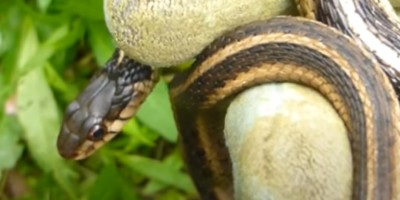 Eastern Garter Snake:
The eastern garter snake (Thamnophis sirtalis sirtalis) is a cousin of the Butler’s garter snake. Like most garter snakes, it has the characteristic three pale stripes down its body, on a darker background of brown or black. Growing to 18 to 26 inches long, they hunt anything they can tackle, including toads, frogs, slugs, and worms. They are extremely common and are thankfully non-venomous. You’ll often see them in city parks as well as suburban yards and gardens. They can be active in either day or night – though they do like to bask in the sun. If you attempt to pick one up, they will release a foul-smelling musk as a deterrent.
Eastern Garter Snake:
The eastern garter snake (Thamnophis sirtalis sirtalis) is a cousin of the Butler’s garter snake. Like most garter snakes, it has the characteristic three pale stripes down its body, on a darker background of brown or black. Growing to 18 to 26 inches long, they hunt anything they can tackle, including toads, frogs, slugs, and worms. They are extremely common and are thankfully non-venomous. You’ll often see them in city parks as well as suburban yards and gardens. They can be active in either day or night – though they do like to bask in the sun. If you attempt to pick one up, they will release a foul-smelling musk as a deterrent.
Venomous Snake Species in Detroit
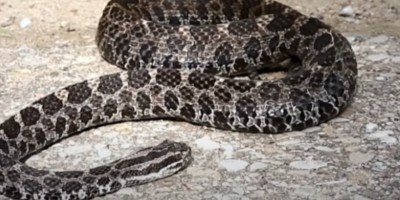 Eastern Massasauga Rattlesnake:
Found throughout the lower peninsula, the Eastern Massasauga (Sistrurus catenatus) prefers swamps, bogs, sedge meadows, and wetlands. However, they are occasionally seen in suburbia. They are the only venomous snake in the state of Michigan, but will not bite unless provoked. Listen for the characteristic rattle. These snakes have thick bodies and triangular heads. Down their back are chocolate brown blotches on a pale grey background. Being a dominant predator, they hunt for mice and voles, but will also hunt frogs and other snakes if located near water. They are ambush predators, waiting for prey to pass by. So, they might be close, and you’d never spot one.
Eastern Massasauga Rattlesnake:
Found throughout the lower peninsula, the Eastern Massasauga (Sistrurus catenatus) prefers swamps, bogs, sedge meadows, and wetlands. However, they are occasionally seen in suburbia. They are the only venomous snake in the state of Michigan, but will not bite unless provoked. Listen for the characteristic rattle. These snakes have thick bodies and triangular heads. Down their back are chocolate brown blotches on a pale grey background. Being a dominant predator, they hunt for mice and voles, but will also hunt frogs and other snakes if located near water. They are ambush predators, waiting for prey to pass by. So, they might be close, and you’d never spot one.
If you're unsure, you can email me a photo of the snake at info@detroitsnakes.com and I will email you back with the snake's species. If you found a snake skin, read my Found a Skin? page, and you can email me a photo of the skin, and I'll identify the snake for you. If you need professional Detroit snake removal help, click my Get Help page, or see the below website sponsor I found, who provides that service.
Remember, the term is not poisonous snakes of Detroit, it's venomous snakes of Detroit. Poison is generally something you eat, and venom is injected into you. That said, dangerous snakes are very rare in Detroit. The few venomous snakes of Wayne County are rarely seen. But they are commonly misidentified, so learn about all the snake species of Detroit in order to correctly identify them. These snakes are usually also found in the surrounding towns of Wayne, Dearborn, Livonia, Canton, Westland, Taylor, Plymouth, Grosse Pointe, Redford Charter Township, Belleville, Romulus, Allen Park, Garden City, Dearborn Heights, Wyandotte, Inkster, Lincoln Park, Grosse Ile Township, Hamtramck, Southgate, Trenton, Highland Park, Flat Rock, Harper Woods, Ecorse, Grosse Pointe Park, River Rouge, Grosse Pointe Farms, Brownstown Charter Township , Woodhaven, Grosse Pointe Woods, Melvindale, Plymouth Charter Township, Van Buren Charter Township, Township of Northville,and the surrounding areas.
Read our article about:
Possible Reasons Why Snakes Bite
detroitsnakes.com domain and hosting costs made possible by the generous support of this sponsor:
